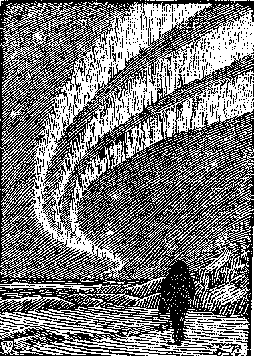The Polar Aurora A woodcut of the aurora, by explorer Fridtjof Nansen. Many people view the polar aurora ("northern lights") as a rare phenomenon. It is indeed rare at most centers of population, but in Alaska, for instance, or in much of Canada, the aurora is quite common. Its greenish arcs, often consisting of many parallel rays (picture above), may stretch quietly across the sky, with the rays constantly fading as new ones appear. At other times the arcs may be agitated, move rapidly, expand or fade, as if manipulated by an unseen hand. What is the aurora? Where does its light come from, and what causes it? In the 1800s it was already evident that the Earth's magnetic field was involved: auroral rays seemed to follow the Earth's magnetic field lines, and the frequency with which aurora was observed depended on the distance from the magnetic pole, not from the geographic one. The typical height of the aurora turned out to be about 100 km or 60 miles, placing it in the upper fringes of the atmosphere. In the late 1800s scientists experimented with electric phenomena in glass containers from which most of the air had been pumped out, and produced there beams of what seemed to be negatively charged particles, later named electrons. When electrons hit an obstacle, they can produce light (television screens and computer monitors operate that way), leading to the idea that perhaps the aurora was produced like that, too, when beams of electrons from outer space entered the atmosphere. The idea gained support when Kristian Birkeland in Norway, around 1895, aimed an electron beam at a spherical magnet and found it was guided towards the magnetic poles of the sphere. Instrumented rockets and satellites later confirmed the existence of such electron beams in the aurora, measured their energies and even photographed from above the world-wide distribution of aurora. But we are still learning about how this happens and where the aurora's energy comes from.
ElectronsElectrons are also most useful in encoding and processing information electrically, a field known as electronics. Nowadays this usually involves transistors, where electrons are loosely held inside a semiconducting material; but at one time all electronic devices--radios, TVs, even early computers--relied on vacuum tubes, in which a hot wire emitted electrons and an arrangement of electrified grids and coils controlled their motion. Short electromagnetic waves carry enough energy to eject electrons from matter, in particular ultra-violet light and x-rays. A near-vacuum is necessary for any such procedure to be effective, because in ordinary air free electrons collide with molecules, lose their energy and are recaptured. In most of space however matter is so rarefied and encounters are so few that free electrons persist for a long time. As we climb upwards through the atmosphere, space conditions begin at about 70 km or 45 miles, where electrons liberated by sunlight last long enough to allow air to conduct electricity to a significant degree. That is the beginning of the ionosphere, a layer with enough free electrons (and ions) to play an important role in radio communications. At sunset the electrons of the lowest part of the ionosphere are quickly recaptured and that layer disappears. However, at about 200 km (120 miles), where the density of free electrons is the greatest (up to a million in each cubic centimeter), collisions are so few that the ionosphere persists day and night.
Positive IonsThe simplest atom is the one of hydrogen, with just one electron. Tearing off that electron gives the simplest ion, the proton. The proton has a close relative, the neutron--nearly the same mass, but no electric charge--and together these two form the basic building blocks from which the nuclei of all atoms are constructed. Most of the fast ions in the magnetosphere and in the solar wind are protons. In the ionosphere one would expect to see ions of oxygen or nitrogen, the main atmospheric gases, and in fact most ions there are O+, oxygen atoms which have lost one electron (out of eight). Some O+ ions end up in the radiation belt, greatly energized by magnetic storms.
PlasmaThe ionosphere above our heads is a plasma. Unlike air, it conducts electricity, and in fact, the ionosphere in the polar regions carries large electric currents, as is discussed in a later section. The electric conductivity of the ionosphere, unlike that of metals or seawater, is very much influenced by the Earth's magnetic field. This is a rather special plasma, because the ionosphere also contains a fairly high number of neutral atmospheric molecules, with which the ions and electrons constantly collide. In contrast, collisions are extremely rare in the solar wind. If this were an ordinary gas, or if the Earth lacked a magnetic field, the solar wind would have penetrated all the way to the top of the atmosphere and would then have flowed around the Earth, the way water flows around a rock in a stream. Something like that in fact happens at the planet Venus, which seems to have no magnetic field of its own. At Earth, however, a strong magnetic field confronts the solar wind, forming a much bigger obstacle than the Earth itself. Because the solar wind is a plasma, it is forced to detour around the Earth's field, creating a large shielded cavity around the Earth--the magnetosphere. The explanation of space phenomena thus requires a good understanding of plasma physics. Unfortunately, no laboratory can duplicate the large dimensions and the very low particle collision rates found in space plasmas. The behavior of such plasmas can be sometimes simulated by computers, but ultimately, to figure what actually happens, one needs to send instruments into space and study their observations.
|
 More about the aurora
More about the aurora More about electrons
More about electrons More about positive ions
More about positive ions More about plasmas
More about plasmas